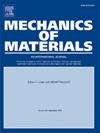自发双稳定性的液晶固体光束和状态转变通过卡扣通过屈曲
IF 3.4
3区 材料科学
Q2 MATERIALS SCIENCE, MULTIDISCIPLINARY
引用次数: 0
摘要
液晶固体作为一种软质活性材料,在各种外界刺激下能够发生可逆的自发变形。本文从力学角度研究了LC实心梁的自发弯曲及其双稳性,普遍适用于以等效自发应变为模型的各种外部刺激。LC实体梁的自发应变通常包括轴向正应变和横向剪切应变。因此,我们将von Kármán几何非线性引入到包含自发横向剪切应变影响的LC实体梁模型中,推导出控制方程和相应的弯曲解。结果表明,梁的双稳性是由梁内部的轴向压缩力引起的,轴向压缩力是由梁的自发伸长受到约束而产生的。当梁表现出双稳性时,两种稳定的弯曲状态是相反的,它们之间的过渡可以通过施加一个反向的横向机械载荷来实现,从而导致卡嗒-通过屈曲。此外,通过几种不同的方法得到了梁表现出自发双稳性和经历机械咔嗒穿过屈曲的临界条件。我们的研究结果有望为LC固体和广泛的材料的应用提供有价值的见解和理论指导,这些材料在涉及多种外部刺激的情况下,在传感、驱动和能量吸收方面表现出类似的自发染色反应。本文章由计算机程序翻译,如有差异,请以英文原文为准。
Spontaneous bi-stability of liquid crystalline solid beams and state transitions via snap-through buckling
Liquid crystalline (LC) solids, as a type of soft active material, are capable of undergoing reversible spontaneous deformation in response to various external stimuli. This paper investigates the spontaneous bending of LC solid beams and the bistability of this phenomenon from a mechanics perspective, with general applicability to various external stimuli modeled as equivalent spontaneous strains. The spontaneous strain in the LC solid beam typically involves both axial normal strain and transverse shear strain. Therefore, we incorporate von Kármán geometric nonlinearity into an LC solid beam model that includes the effects of the spontaneous transverse shear strain to derive the governing equation and relevant bending solution. The results demonstrate that the bistability arises from the compressive axial force within the beam, which is generated by the constraint on its spontaneous elongation. When the beam exhibits bistability, the two stable bending states are oppositely directed, and the transitions between them can be achieved by applying a reversed transverse mechanical load that causes snap-through buckling. Furthermore, the critical conditions for the beam to exhibit the spontaneous bistability and to undergo the mechanical snap-through buckling are obtained through several distinct approaches. Our results are expected to offer valuable insights and theoretical guidance for the application of LC solids and a broad class of materials exhibiting similar spontaneous stain responses in sensing, actuation, and energy absorption in scenarios involving diverse external stimuli.
求助全文
通过发布文献求助,成功后即可免费获取论文全文。
去求助
来源期刊

Mechanics of Materials
工程技术-材料科学:综合
CiteScore
7.60
自引率
5.10%
发文量
243
审稿时长
46 days
期刊介绍:
Mechanics of Materials is a forum for original scientific research on the flow, fracture, and general constitutive behavior of geophysical, geotechnical and technological materials, with balanced coverage of advanced technological and natural materials, with balanced coverage of theoretical, experimental, and field investigations. Of special concern are macroscopic predictions based on microscopic models, identification of microscopic structures from limited overall macroscopic data, experimental and field results that lead to fundamental understanding of the behavior of materials, and coordinated experimental and analytical investigations that culminate in theories with predictive quality.
 求助内容:
求助内容: 应助结果提醒方式:
应助结果提醒方式:


